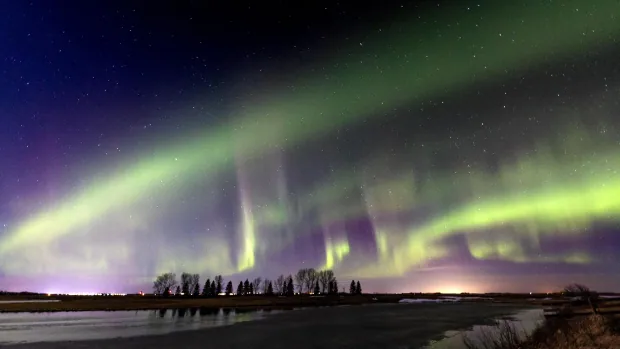There’s been a flurry of activity on the sun over the past few days, which means we may get a chance to see a good display of the northern lights tonight.
On Wednesday, the sun burped out a wave of charged particles that, if they reach Earth and interact with our magnetic field, may put on a spectacular light show.
Our sun goes through an 11-year cycle where activity waxes and wanes. Currently, we are in a period of heightened activity where the sun produces more sunspots, relatively cooler areas on the sun’s surface.
But because the sun — which has an incredibly powerful magnetic field — isn’t a solid mass and different parts rotate at different speeds, the magnetic fields around these sunspots can sometimes get entangled and then spontaneously snap producing a solar flare. These flares can disrupt radio transmissions here on Earth.
Often, these solar flares are followed by something called a coronal mass ejection (CME), where charged particles erupt quickly and are carried along by the solar wind.
If Earth is in its path, the particles can disrupt our magnetic field, pushing it backward until it snaps and the particles are funnelled towards the poles.
But not every CME results in great displays of northern lights, also called aurora borealis.
For example, there is something called an auroral oval around both the north and south poles. How far south the auroras can be seen depends on a few factors, including the speed and strength of the particles as well as whether or not the oval tilts south (for those in the northern hemisphere).
How and when
According to the U.S. National Oceanic and Atmospheric Administration’s (NOAA) Space Weather Prediction Center, there is a chance of a moderate geomagnetic storm Friday night.

There is some debate over whether or not we will get a storm powerful enough to be seen in lower latitudes, for example, in parts of southern Ontario and into the northern United States.
Geomagnetic activity is measured on something called a Kp index. The higher the number, the better chance the aurora will be visible in lower latitudes. Some aurora watchers are predicting a Kp index of 8 or 9 — which is quite high — while others believe it won’t be that powerful.
That’s because the solar flare associated with the CME was moderate and not that powerful.
I agree. The NASA & NOAA <a href=”https://twitter.com/hashtag/solarstorm?src=hash&ref_src=twsrc%5Etfw”>#solarstorm</a> predictions look awfully strange given the small source region, overall weakness of the EIT wave, and dimness of the full-halo coronagraph signature. I will be surprised if it results in a a Kp 8-9. The associated flare was only a C5.6-flare. <a href=”https://t.co/co9I52zA9Z”>https://t.co/co9I52zA9Z</a>
—@TamithaSkov
Either way, if the sky is clear tonight, you should still be on the lookout.
The best way to see them is to head out to a dark-sky location with a decent view to the north. The sun doesn’t set until late in the evening, so you may need to wait until it is quite dark.
In order to see them from a light-polluted city like Toronto or Montreal, however, the Kp index will have to be quite strong, such as a 9 or 10, which isn’t impossible.
Sometimes, if it’s a weak storm, aurorae are just not visible to the human eye. However, since cameras are able to leave their shutters open for longer exposures, you may want to try setting up a camera on a tripod and take a 10– to 20–second exposure set to ISO 800 to see if they’re there, but simply not visible to you.
For updates, there are plenty of free apps like Northern Light Aurora Forecast and My Aurora Forecast & Alerts where you can keep an eye on the Kp index in real time.
You can also visit websites like Spaceweather.com and SpaceWeatherLive.
And if the forecast doesn’t come through, don’t worry: the sun has only just begun its maximum phase so there will likely be a few more years of heightened solar activity and aurora displays.


